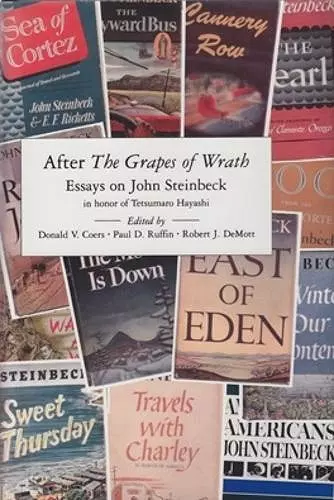After the Grapes of Wrath
Essays on John Steinbeck in Honor of Tetsumaro Hayashi
Robert DeMott editor Donald V Coers editor Paul D Ruffin editor Warren G French editor
Format:Hardback
Publisher:Ohio University Press
Published:1st Mar '95
Currently unavailable, and unfortunately no date known when it will be back

Traditionally, the critical reputation of Nobel Prize-winning American novelist John Steinbeck (1902-1968) has rested on his achievements of the 1930s, especially In Dubious Battle (1936), Of Mice and Men (19370, The Long Valley (1938), and, of course, The Grapes of Wrath (1939), one of the most powerful – and arguable on of the greatest – American novels of this century.
Book reviewers and academic critics often turned antagonistic toward Steinbeck when he no longer produced work with the sweeping reach and social consciousness of The Grapes of Wrath. He was accused of selling out, or co-opting his talent, when in fact the inordinate public success of Grapes and especially its attendant notoriety had caused a backlash for Steinbeck. As a result he became self-conscious about his own ability, and suspicious of that “clumsy vehicle,” the novel. The very act of researching and writing Grapes, which occupied him fully for several years and which he had already conceived as his final book on proletarian themes, changed him drastically.
No longer willing to be the chronicler of Depression-era subjects, Steinbeck went afield to find new roots, new sources, new forms. For example, in the six years following the publication of Grapes, Steinbeck completed a suit of love poems; a full-length novel (bastardized by Alfred Hitchcock in his 1943 film, Lifeboat); a nonfiction scientific book, Sea of Cortez: A Leisurely Journal of Travel and Research (with Edward F. Ricketts); a documentary film, The Forgotten Village; a documentary book to help the war effort, Bombs Away: The Story of a Bomber Team; a series of articles he wrote as a war correspondent for the New York Herald Tribune (later collected as Once There Was a War); and two novels, The Moon Is Down and Cannery Row.
Steinbeck came to define himself less as a novelist and more as a man of letters, a restless experimenter with form and subject matter, and a prophetic postmodernist whose key subject for the rest of his career was the dilemma of individual choice and ethical consciousness. Thus, Steinbeck’s later fiction, from The Moon Is Down (1942) through The Winter of Our Discontent (1962), and his later nonfiction, from Sea of Cortez (1941) through Travels with Charley (1962) and America and...
“What about John Steinbeck after The Grapes of Wrath? This collection in honor of Tetsumaro Hayashi provides a much welcome, contemporary response to this often-asked question about a relatively overlooks, enigmatic period of Steinbeck's career.” * Yasuda Women's University *
“The very things that so empowered John Steinbeck's work—the wisdom, depth, and diversity—are generously represented in the remarkable collection. And what a fitting testament to Tetsumaro Hayashi, who in his insight stimulated the interest of many of us in Steinbeck, nurtured a companionship among us, and encouraged our own explorations.” * Calvin College *
ISBN: 9780821411025
Dimensions: unknown
Weight: unknown
265 pages